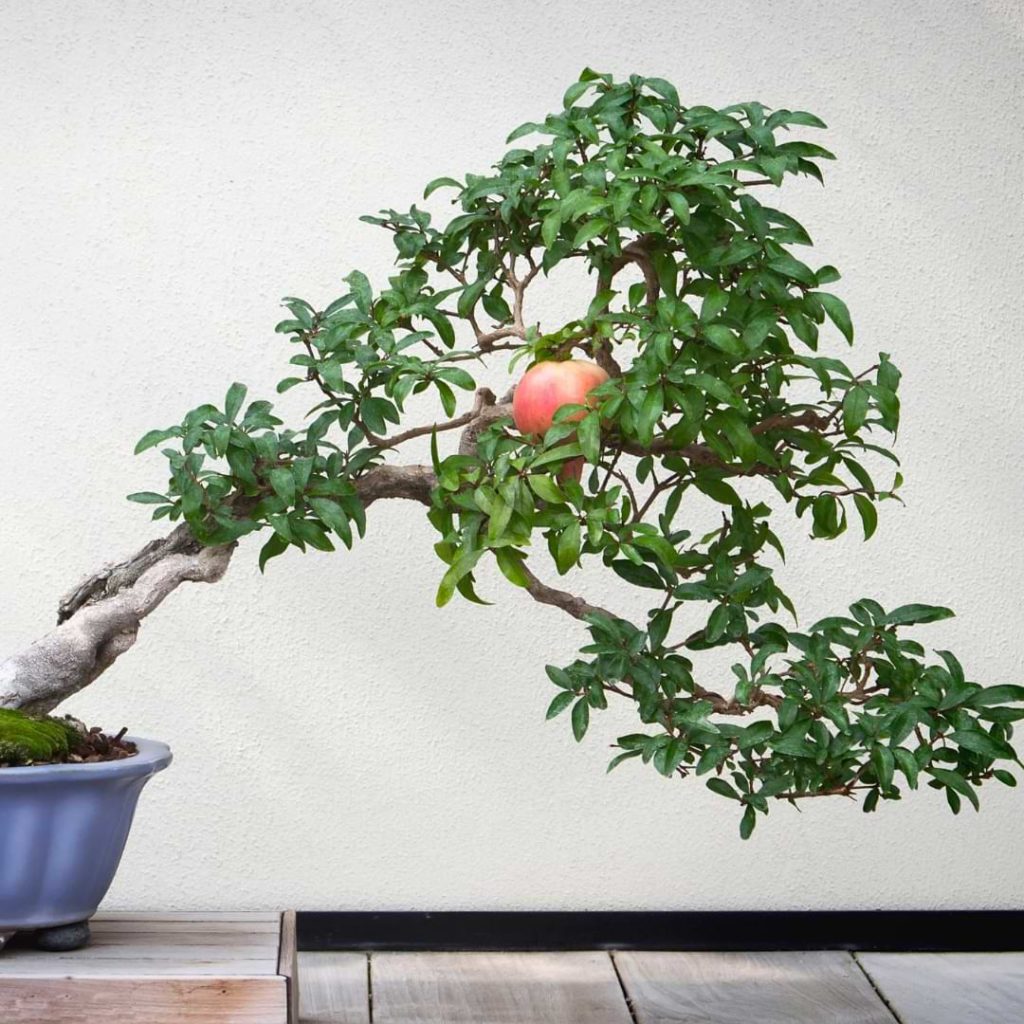Pomegranate trees have many features that make them attractive as bonsai: a thick trunk with interesting bark as well as eye-catching flowers that bear fruit. Native to the Middle East and Southeast Asia, this striking tree has been a popular bonsai choice in Japan for centuries.
Can You Bonsai a Pomegranate Tree?
People have enjoyed pomegranate tree bonsai for many years. While certainly not the easiest tree to bonsai, it is continually popular with bonsai lovers.
Part of the pomegranate tree’s popularity comes from its unique appearance; a pomegranate tree’s trunk has bark with a natural twist that makes the tree look ancient and gnarled, and the tree also has beautiful flowers and fruit.
Trying to bonsai a pomegranate tree is not the best option for those new to bonsai—other beloved bonsai trees would be better for those with less experience. However, pomegranate trees do make beautiful bonsai trees when given the proper care and training.
How Do You Start a Pomegranate Bonsai Tree?
If caring for a pomegranate bonsai tree sounds interesting, you have several options for obtaining one.
The easiest method is to find a pomegranate bonsai tree that has been shaped by a professional. But this method can be pricey, and it can be difficult to find a good pomegranate bonsai tree depending on your location.
Local nurseries may have pomegranate trees available. These trees would already be growing, but you’d need to shape and train the tree yourself.
Another option is to grow your pomegranate tree from a seed, which is fairly easy. However, you’ll need to have the time and patience to wait for the tree to grow, and then you’ll need to spend additional time shaping and developing the tree into a proper bonsai shape. Also, be aware that pomegranate seeds don’t always grow true to variety; you could get a different type of pomegranate than the type the seed came from.
You can also start a pomegranate tree by propagating it from a cutting. The advantage to this method is that you’ll know in advance what variety of pomegranate tree you’ll get because the new tree will be a clone of the mother tree.
We’ll talk more about what the process of starting a new tree from seed looks like as well as what starting a new tree from a cutting looks like. Both of these are fairly reliable methods of creating a new pomegranate tree, and it’s fun to watch a new tree grow over time.
Pomegranate Bonsai Indoor or Outdoor
Whether you should keep your pomegranate bonsai indoors or outdoors depends on your climate. Pomegranate trees can survive outdoors year-round in Mediterranean climates, so if that is the case for you, your pomegranate bonsai tree can stay outdoors.
For most people, pomegranate bonsai can either be kept outdoors during warm months and sheltered during cold months, or it can be kept indoors year-round. Just know that pomegranate bonsai trees thrive in warm weather and sunshine, so you may have a healthier bonsai if you are able to bring it outdoors during the summer months rather than keeping it indoors all the time.
The ideal temperature for pomegranate bonsai trees is above 41 degrees Fahrenheit. They need lots of sun during the summer but don’t require as much light when they are dormant during the winter.
How Do You Start a Pomegranate Bonsai Tree?
If you want to go the route of starting a pomegranate bonsai tree from seed, you’ll be glad to know that the process is fairly easy. (It’s the care afterward that gets tricky.)
You’ll need the following supplies:
- Pomegranate seeds
- Potting soil
- Shallow containers
- Clear plastic bags
Step 1: Moisten the soil with water and place in shallow containers.
Step 2: Place the seeds in the containers and cover them with a clear plastic bag to prevent moisture loss.
Step 3: Keep the seeds in a warm location (and make sure the soil stays moist) until you see the seeds begin to germinate. Expect to wait 30-40 days before germination. Then remove the plastic bags.
Step 4: Continue watering your tiny seedlings as they grow. Once the seedlings outgrow their current containers, move them into larger pots.
Step 5: When grown in containers, pomegranate tree trunks are more spindly than those grown in the ground. To get a good trunk for bonsai, you will likely need to plant your pomegranate tree in the ground for a season if possible.
Propagation
When you grow pomegranate trees from seeds, there’s no guarantee what species and cultivar you’ll get because seeds don’t always resemble their mother tree. However, if you propagate from a cutting, you’ll get the same species and cultivar as the parent. If you have access to cuttings from a pomegranate tree, propagating can be a great option for starting a pomegranate bonsai tree.
First, you’ll need to take the cuttings from a healthy pomegranate tree. Take the cuttings during late winter, making sure that each cutting is about 10 inches long and has a diameter of about ¼ to ½ inch.
Dip the cut ends into commercial growth hormone. This makes it more likely that your pomegranate cuttings will take root. Insert the end of the cuttings into its own container with moist soil. Make sure that the top node of each cutting stays above the soil.
Provide water as needed. Once roots develop, move the seedling to larger containers if necessary. Just like with pomegranates started from seed, you may need to plant these tiny pomegranate trees in the ground for a season or two to encourage the trunk to become more robust.
Pruning, Wiring, & Shaping
When your pomegranate tree is mature enough, it’s time for you to decide on the bonsai style you want to achieve. You’ll need your pomegranate bonsai to be medium or large in size in order for it to be able to produce fruit. Just know you’ll need to keep some portion of the fruit from developing because a bonsai won’t be able to handle the same level of production as a full-size pomegranate tree.
Plan to do most pruning during the winter while the pomegranate tree is dormant. When you trim the shoots during the growing season, do so once the shoots have reached between 4 and 6 inches in length.
Placing wiring during the winter is also a good choice because you don’t have to avoid the leaves. Older branches don’t respond well to wire, but younger branches are more flexible.
Shaping a pomegranate bonsai can be difficult because the tree grows fairly rapidly compared to most other popular bonsai. They need care and attention on a regular basis in order to keep a proper shape. While pomegranate bonsai is not the ideal choice for someone new to bonsai, many bonsai lovers have proven that it’s possible to have gorgeous pomegranate bonsai trees after becoming more experienced.

Pomegranate Bonsai Punica Granatum
To successfully grow a pomegranate bonsai, you need to know what kind of care makes it thrive. Pomegranates are a little bit fussy when it comes to care, but they’re so beautiful that it’s easy to forgive their high-maintenance needs.
Height & Width
You’ll want to keep most pomegranate bonsai trees between 1 to 2 feet tall depending on the variety and bonsai style you’re going for.
Light
During the summer months while the pomegranate tree bonsai is doing the majority of its growing, the plant prefers as much sun as possible. If you live in a particularly hot climate, the pomegranate may need some shade during the hottest part of the day. If you decide to keep your pomegranate tree bonsai indoors year-round, give it as much sun as possible during the summer.
During the winter months, pomegranate trees prefer more shade. If you’re lucky enough to be able to keep your pomegranate outdoors during the winter, you may need to move it to a more sheltered location. If your pomegranate is indoors during the winter, it doesn’t have to be in the sunniest location in your home.
Temperature and Humidity
Pomegranate bonsai are very heat-tolerant, so it’s unlikely you’ll be able to place it somewhere that is too hot. However, they start to have issues with cold weather when the temperature gets close to 40 degrees Fahrenheit. When temperatures start to drop, it’s time to bring your pomegranate bonsai indoors.
Pomegranates do not like high levels of humidity. While the plant can tolerate this kind of weather if necessary, it’s more likely to develop good fruit in areas with low humidity. Providing access to good airflow (or good breezes) can help pomegranate bonsai better tolerate high humidity.
Soil
Pomegranate bonsai need a well-draining soil mix because they do not enjoy sitting in water for a long period. For this reason, it’s important that your pomegranate be planted in a container with adequate drainage holes so the water has some way to escape.
Water
Pomegranate bonsai trees need regular watering. The soil should be moist but not soaking wet. Try to avoid allowing the soil to dry out completely between waterings, especially during the summer.
Since container size, temperature, location, and maturity all affect how much water a pomegranate bonsai tree needs, you’ll have to rely on observing your plant. During particularly hot days, you may need to water your bonsai twice. During the winter, you can go much longer without watering partly because the plant is not doing as much growing during this time.
Fertilizing
Pomegranate bonsai trees benefit from some added fertilizer beginning in the spring. We like to use a liquid fertilizer because these are easy to dilute as needed. Start by applying half the recommended amount for your bonsai; you can always up the amount later if needed.
Stop applying fertilizer during the fall so the pomegranate bonsai is prepared for its dormant season. Note that you also won’t need to use fertilizer for several months after repotting because most fresh potting soil will have enough nutrients for your plant during that time.
Potting and Repotting
Repot pomegranate bonsai trees only when the plants become root-bound, generally every 3 to 5 years. However, you may need to repot more often with a young tree than with one that is older.
Repot your bonsai at the end of winter before new growth begins. When you repot, remove some of the plant’s roots; you can trim up to a third of the root ball each time you repot. Be sure to use sterilized tools when trimming so you don’t accidentally introduce any harmful bacteria to your plant’s roots.
If you wait too long to repot, your bonsai will begin to suffer. Not only does repotting allow the bonsai roots to have more room, it also gives you a chance to refresh the soil.
Common Pests/Diseases
Healthy pomegranate trees are rarely bothered by pests and disease. The most frequent issue is overwatering, which can cause root rot. Make sure you use well-draining soil for your pomegranate bonsai and that it’s possible for excess water to escape from its container.
A few pests like aphids, scale, whitefly, and mealy bugs may sometimes try to attack pomegranate trees. If you notice signs of damage from these pests, you can generally solve the problem with homemade remedies first. Then move to pesticides if necessary. When using pesticides, follow the instructions carefully to avoid harming yourself and your pomegranate tree bonsai.
Bonsai With Us!
The Bonsai Resource Center is here to help you learn about all things bonsai and provide you with the tools you need to keep your plant healthy and strong. Explore our other articles, visit our online shop, and connect with other bonsai lovers in our Facebook group to learn everything you need to know about this rewarding hobby!



